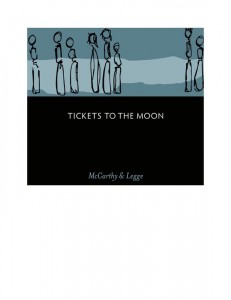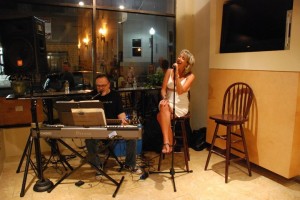How to Create an Album: Tickets To The Moon

While all of us listen to music, many of us do not know just how much work goes into completing an entire album. Along with my recording partner Dori Legge, I recently finished recording one, entitled Tickets To The Moon. Here are the steps we had to take in order to make this album a reality.
1. WRITE SOME SONGS
I thought I’d start with the hardest part. It helps to have a very talented collaborator who’s not afraid to tell you when your idea for a song just doesn’t work. That’s what I’ve found in Dori Legge. And it works both ways- some songs are shot down from the very beginning and they die on the vine. A lot of the songs start with a good title like “Gone Missing”. I had this song title in my head for quite some time after my wife mentioned that someone she works with uses that phrase when fellow employees seem to disappear at crunch time. The first attempt at this song was greeted with a “Hmmmm…” from Dori, which pretty much means, “Nope. Try again.” I have dozens of MP3’s of the various takes on this song, some of which are pretty dismal, but the core of the lyric was good so we kept at it, swapping ideas back and forth over several months. We borrowed the bridge from a song idea of Dori’s that never worked out for some reason and the end result is a really strong song (I think) and is Track 2 on the new CD. We wrote maybe 25 songs from February 2010 until just before we went into the studio- two of the tracks were written at the last minute. We whittled that down to the best 11 songs.
2. GET THE RIGHT PLAYERS
Luckily we have some great players in our inner circle, all from the South Coast area: Chris Richards (guitar), Steve Mazza (bass), John “JB” Borges (drums) and Dan “Dr. D” Schwartz (percussion) make up the core group when we play live and we’re lucky to have these guys on most of the tracks. This time we also widened the talent circle and invited Michael Lavoie (bass), Matt Antunes (drums), Matt Richard (piano), Donn Legge (guitar), Nikki Engstrom (violin) and Bonnie Breault (accordion) to help us out.
3. REHEARSE. REHEARSE. REHEARSE
We insist on going into the studio totally prepared to do all the basic tracks. We’re lucky to have players who put up with our demands and get the job done.
For this album, we wanted first and foremost a good piano sound. Most of our material is piano-based and recording with an electronic piano was not what we wanted. We found a studio in Middleboro called ‘Sounds Interesting Studio’ that had a beautiful Yamaha Baby Grand Piano. I also knew the engineer Rob Pemberton. We went for a studio tour and hit it off with Rob right away. The studio was built on a horse farm out in the country; horses are roaming around the grounds and the studio is state-of-the-art and quite beautiful. It was an easy decision. We decided in the parking lot right after the tour.
5. SCHEDULE TIME/BUDGET MONEY
It takes a LOT of time and money. You don’t want to know how much money, believe me. Time-wise, we booked tw weeks in October with the goal of finishing all 11 songs in that time frame. Hahaha. We did get a lot done, but we did not reach that goal. We finished most of the instrument tracks, but we had to book more time to do the vocals. Lots of over-dubbing and harmonies. It was during this period when we realized that Rob was a great collaborator- he had lots of ideas and a very discerning ear. Plus, he wasn’t shy about saying, “No”. We sort of put ourselves in his hands so we could concentrate on performing the music. Rob moved from Engineer to Producer and that made all the difference. This part of the process was the most fun and creative and it’s over much too quickly. We could definitely do this all the time if we could afford it!
6. THE MIXING
This involves the magic of recording, and I have no idea how it works. Having an expert engineer with all the tools at his disposal helps. Rob would mix down each track and give us a CD and we’d make notes and he would make changes. Mostly we went with Rob’s mix with little tweaks here and there. This process took about three weeks.
7. THE MASTERING
Another magical process completely beyond my ken. We used Soundmirror Inc. in Boston to master the tracks. Basically, the mastering takes the mix and makes it brilliant, like cleaning your dirty windows and letting the sun shine through. They did a great job.

8. THE ART WORK
There’s more!! Of course the CD needs to be packaged. We are both big fans of local artist Shelley Cardoos. We had wanted to use her images on our first album “Damaged Goods”, but opted for a photo instead. This time we went with Shelley’s stylized figures in blue. Hannah Haines at mediumstudio did the cover design and the result is fantastic. All this had to be planned in advance and coordinated with the recording side of things. Reading this back, I’m not sure how we did it. Dori deserves most of the credit for keeping it all organized and moving forward like a Great White Shark.
9. THE LABEL
We went with Whaling City Sound Records- a great local label. Neal Weiss was very supportive and we’re glad to be in their stable of artists.
10. DUPLICATION
Once we had all the tracks mastered and the cover design complete, it was time to make copies! Disc Maker in New Jersey did the job and at long last the 1,047 CDs arrived.
Finally, after all the hard work is done, you are ready for your record release party with your finished CD!
